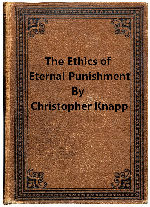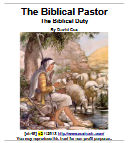The Epistles of St. John: 21 Discourses
By William Alexander, D.D., D.C.L.
Brasenose College, Oxford,
Lord Bishop of Derry and Raphoe.
(from The Expositor’s Bible) EDITED BY THE REV. SIR W. ROBERTSON NICOLL, M.A., LL.D.
Editor of “The Expositor”; etc.
SECOND THOUSAND.
HODDER AND STOUGHTON,
27, PATERNOSTER ROW.
MDCCCLXXXIX. (1889)
My first impression of this book is that it probably has great and tremendous information, but it is from “yester-year” and its form is difficult to get the jewels out of it. But this is a 25 chapter commentary on John’s Epistles, even though his treatment is not straight in the order of verses commented on.
Table of Contents
Preface
First Epistle
Part 1
Chapter 1 – The Surroundings of the First Epistle of St. John
Chapter 2 – The Connection of the Epistle with the Gospel of St. John
Chapter 3 – The Polemical Element in the First Epistle of St. John
Chapter 4 – The Image of St. John’s Soul in His Epistle
Part 2
Some General Rules for the Interpretation of the First Epistle of St. John
Chapter 5 – Analysis and Theory of St. John’s Gospel
Chapter 6 – St. John’s Gospel Historical, not Ideological
Chapter 7 – Extent of the Atonement
Chapter 8 – Missionary Application Of the Extent of the Atonement
Chapter 9 – The Influence of the Great Life Walk a Personal Influence
Chapter 10 – The World which We Must Not Love
Chapter 11 – Use and Abuse of the Sense of the Vanity of the World
Chapter 12 – Knowing All Things
Chapter 13 – Lofty Ideals Perilous unless Applied
Chapter 14 – Boldness in the Day of Judgment
Chapter 15 – Birth and Victory
Chapter 16 – The Gospel as a Gospel of Witness; the Three Witnesses
Chapter 17 – The Witness of Men (Applied to the Resurrection)
Chapter 18 – Sin unto Death
Chapter 19 – The Terrible Truism which has No Exception
Second Epistle
Chapter 20 – Theology and Life in Kyria’s Letter
Third Epistle
Chapter 21 – The Quietness of True Religion
Preface
IT is now many years ago since I entered upon a study of the Epistles of St. John, as serious and prolonged as was consistent with the often distracting cares of an Irish Bishop. Such fruit as my labours produced enjoyed the advantage of appearing in the last volume of the Speaker’s Commentary in 1881.
Since that period I have frequently turned again to these Epistles – subsequent reflection or study not seldom filling in gaps in my knowledge, or leading me to modify former interpretations. When invited last year to resume my old work, I therefore embraced willingly the opportunity which was presented to me. Let me briefly state the method pursued in this book.
I. The First Part contains four Discourses.
(1) In the first Discourse I have tried to place the reader in the historical surroundings from which (unless all early Church history is unreal, a past that never was present) these Epistles emanated.
(2) In the second Discourse I compare the Epistle with the Gospel. This is the true point of orientation for the commentator. Call the connection between the two documents what we may; be the Epistle the Hieronymian interpretation precisely as it stood, not preface, appendix, moral and devotional commentary, or accompanying encyclical address to the Churches, which were “the nurslings of John”; that connection is constant and pervasive. Unless this principle is firmly grasped, we not only lose a defence and confirmation of the Gospel, but dissolve the whole consistency of the Epistle, and leave it floating – the thinnest cloud in the whole cloudland of mystic idealism.
(3) The third Discourse deals with the polemical element in these Epistles. Some commentators indeed, like the excellent Henry Hammond, “spy out Gnostics where there are none.” They confuse us with uncouth names, and conjure up the ghosts of long-forgotten errors until we seem to hear a theological bedlam, or to see theological scarecrows. Yet Gnosticism, Doketism, Cerinthianism, certainly sprang from the teeming soil of Ephesian thought; and without a recognition of this fact, we shall never understand the Epistle. Undoubtedly, if the Apostle had addressed himself only to contemporary error, his great Epistle would have become completely obsolete for us. To subsequent ages an antiquated polemical treatise is like a fossil scorpion with a sting of stone. But a divinely taught polemic under transitory forms of error finds principles as lasting as human nature.
(4) The object of the fourth Discourse is to bring out the image of St, John’s soul- the essentials of the spiritual life to be found in those precious chapters which still continue to be an element of the life of the Church.
Such a view, if at all accurate, will enable the reader to contemplate the whole of the Epistle with the sense of completeness, of remoteness, and of unity which arises from a general survey apart from particular difficulties. An ancient legend insisted that St. John exercised miraculous power in blending again into one the broken pieces of a precious stone. We may try in an humble way to bring these fragmentary particles of spiritual gem-dust together, and fuse them into one.
II. The plan pursued in the second part is this. The First Epistle (of which only I need now speak) is divided into ten sections.
The sections are thus arranged –
(1) The text is given in Greek. In this matter I make no pretence to original research; and have simply adopted Tischendorf’s text, with occasional amendments from Dr. Scrivener or Prof. Westcott. At one time I might have been tempted to follow Lachmann; but experience taught me that he is “audacior quam limatior,” and I held my hand. The advantage to every studious reader of having the divine original close by him for comparison is too obvious to need a word more.
With the Greek I have placed in parallel columns the translations most useful for ordinary readers – the Latin, the English A.V. and R.V. The Latin text is that of the “Codex Amiatinus,” after Tischendorf’s splendid edition of 1854. In this the reader will find, more than a hundred and twenty years after the death of St. Jerome, an interpretation more diligent and more accurate than that which is supplied by the ordinary Vulgate text. The saint felt “the peril of presuming to judge others where he himself would be judged by all; of changing the tongue of the old, and carrying back a world which was growing hoary to the initial essay of infancy.” The Latin is of that form to which ancient Latin Church writers gave the name of “rusticitas.” But it is a happy – I had almost said a divine – rusticity. In translating from the Hebrew of the Old Testament, St. Jerome has given a new life, a strange tenderness or awful cadence, to prophets and psalmists. The voice of the fields is the voice of Heaven also. The tongue of the people is for once the tongue of God. This Hebraistic Latin or Latinised Hebrew forms the strongest link in that mysterious yet most real spell wherewith the Latin of the Church enthrals the soul of the world. But to return to our immediate subject. The student can seldom go wrong by more than a hair’s breadth when he has before him three such translations. In the first column stands St. Jerome’s vigorous Latin. The second contains the English A.V., of which each clause seems to be guarded by the spirits of the holy dead, as well as by the love of the living Church; and to tell the innovator that he “does wrong to show it violence, being so majestical.” The third column offers to view the scholarlike- if sometimes just a little pedantic and provoking- accuracy of the R.V. To this comparison of versions I attach much significance. Every translation is an additional commentary, every good translation the best of commentaries.
I have ventured with much hesitation to add upon another column in each section a translation drawn up by myself for my own private use; the greater portion of which was made a year or two before the publication of the R.V. Its right to be here is this, that it affords the best key to my meaning in any place where the exposition may be imperfectly expressed.1
(2) One or more Discourses are attached to most of the sections. In these I may have seemed sometimes to have given myself a wide scope, but I have tried to make a sound and careful exegesis the basis of each. And I have throughout considered myself bound to draw out some great leading idea of St. John with conscientious care.
(3) The Discourses (or if there be no Discourse in the section, the text and versions) are followed by short notes, chiefly exegetical, in which I have not willingly passed by any real difficulty.
I have not wished to cumber my pages with constant quotations. But in former years I have read, in some cases with much care, the following commentators – St. Augustine’s Tractatiis, St. John Chrysostom’s Homilies on the Gospel (full of hints upon the Epistles), Cornelius a Lapide; of older post-Reformation commentators, the excellent Henry Hammond, the eloquent Dean Hardy, the precious fragments in Pole’s Synopsis – above all, the inimitable Bengel; of moderns, Diisterdieck, Huther, Ebrard, Neander; more recently. Professor Westcott, whose subtle and exquisite scholarship deserves the gratitude of every student of St. John. Of Haupt I know nothing, with the exception of an analysis of the Epistle, which is stamped with the highest praise of so refined and competent a judge as Archdeacon Farrar. But having read this list fairly in past years, I am now content to have before me nothing but a Greek Testament, the Grammars of Winer and Donaldson, the New Testament lexicons of Bretschneider, Grimm, and Mintert, with Tromm’s “Concordantia LXX.” For, on the whole, I really prefer St. John to his commentators. And I hope I am not ungrateful for help which I have received from them, when I say that I now seem to myself to understand him better without the dissonance of their many voices. “Johannem nisi ex Johanne ipso non intellexeris.”
III. It only remains to commend this book, such as it is, not only to theological students, but to general readers, who I hope will not be alarmed by a few Greek words here and there.
I began my fuller study of St. John’s Epistle in the noonday of life; I am closing it with the sunset in my eyes. I pray God to sanctify this poor attempt to the edification of souls, and the good of the Church. And I ask all who may find it useful, to offer their intercessions for a blessing upon the book, and upon its author.
WILLIAM DERRY AND RAPHOE
The Palace, Londonderry
February 6th, 1889
Merciful God, we beseech Thee to cast Thy bright beams of light upon Thy Church, that it being enlightened by the doctrine of Thy blessed Apostle and Evangelist St. John, may so walk in the light of Thy truth, that it may at length attain to the light of everlasting life, through Jesus Christ our Lord. Amen.
1. I venture to call attention to the rendering ” very.” It enables the translator to mark the important distinction between two words : άληθήζ, factually true and real, as opposed to that which in point of fact is mendacious; άγηθινός, ideally true and real, that which alone realizes the idea imperfectly expressed by something else. This is one of St. John’s favourite words. In regard to άγάpη I have not had the courage of my convictions. The word ”charity” seems to me almost providentially preserved for the rendering of that term. It is not without a purpose that ξρωζ is so rigorously excluded from the New Testament. The objection that ” charity ” conveys to ordinary English people the notion of mere material alms is of little weight. If “charity” is sometimes a little metallic, is not “love” sometimes a little maundering? I agree with Canon Evans that the word, strictly speaking, should be always translated “charity” when alone, “love” when in regimen. Yet I have not been bold enough to put “God is charity” for “God is love.”

Knapp The Ethics of Eternal Punishment is a single chapter work on the everlasting or eternity of hell. Christopher Knapp is a brethren author.
PDF: Knapp The Ethics of Eternal Punishment
theWord: Knapp The Ethics of Eternal Punishment
MySword: Knapp The Ethics of Eternal Punishment
eSword: Knapp The Ethics of Eternal Punishment

ch49 The Biblical Pastor: The Biblical Duty outlines the duties of a pastor.
Topics: Pastoral Watchcare | Threats to wicked Pastors | Spiritual feeding | Being a Watchman (warning and protecting) | Pastoral Visitation | Intercession by prayer | Pastoring because you love Christ.
Excerpt: The concept of “visit” or “visitation” refers to the pastoral duty (spiritual watchcare of others) in which he analyzes the problems to effect a remedy. This concept is basically “visit”. Jesus identified the true believer as a person which has the naturally emerging joy to serve and help others.
Read the tract: ch49 The Biblical Pastor: The Biblical Duty.
MySwordmodules is a website dedicate to the MySword Bible Program for Androird devices. We host MySword Modules.

Buy me Steak Taco! You know, I work hard at my websites trying to provide you with good material that is sound doctrinally-speaking and of interest to God's people. It is hard work, but I don't mind doing it, and I feel called to the ministry, and God will bless me after all is said and done. But in the meantime, I do need to cover my expenses. I have a total of 34 websites (half English and half Spanish), and each one costs about $10 per month to keep up. That does not take into consideration my time and effort in writing content. Won't you consider at least a one time donation to this ministry of $10 or $20 dollars? It would be really great if you could gift me and my wife this money so that we could enjoy eating out at least once in a while. (I pay the expenses for these sites out of our living expenses.) God will richly bless you and repay you for your generosity. 1 Timothy 5:18 For the scripture saith, Thou shalt not muzzle the ox that treadeth out the corn. And, The labourer is worthy of his reward. If you received some value from my websites, consider at lest a small donation. A big donation would really be nice, too though.
Donate to David Cox Ministries.
